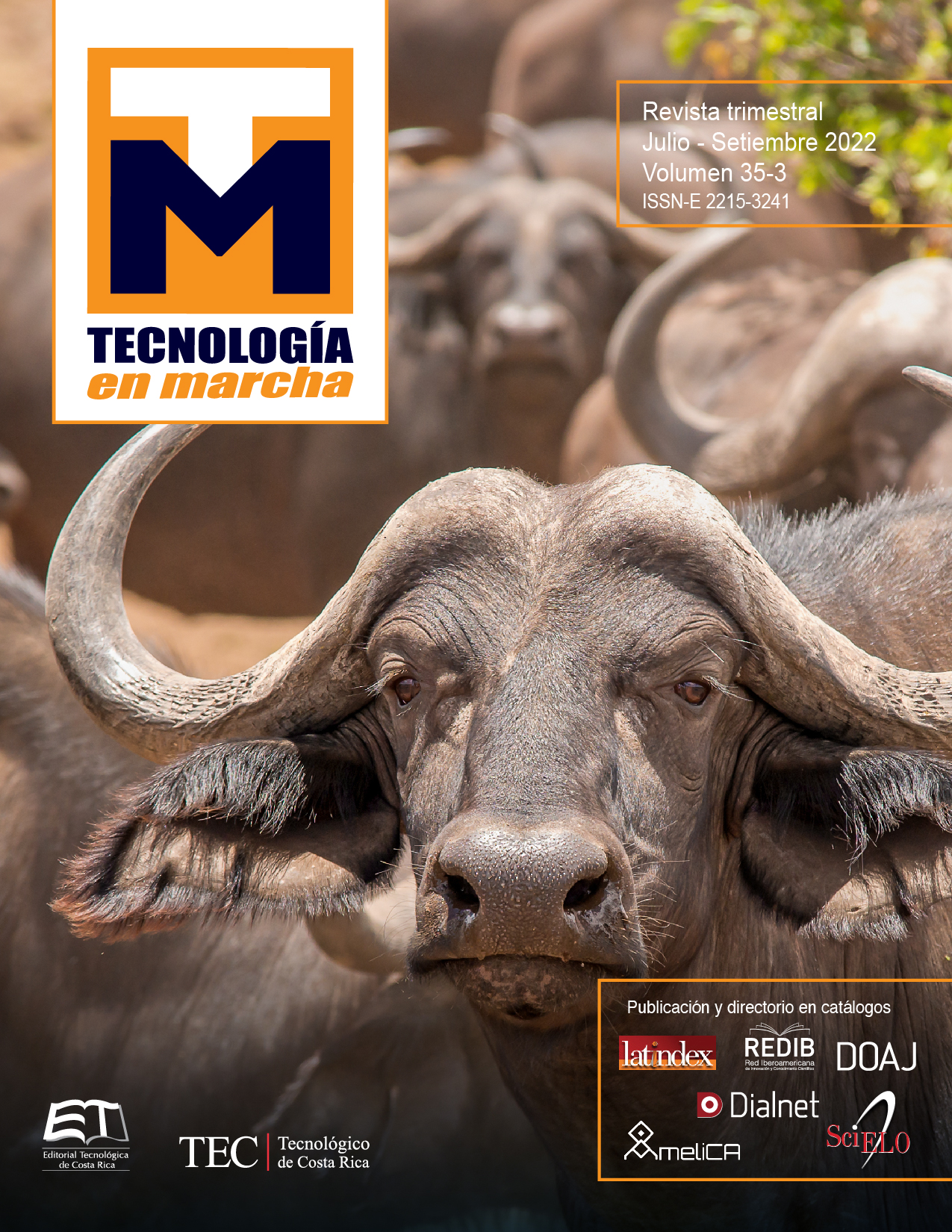Comparative study using different methods for calculating contact tensions in spur gears
Main Article Content
Abstract
One of the most common causes of failure in gear drives is known as surface fatigue or pitting. To predict the behaviour of the material against this phenomenon, international design standards, the American Gear Manufacturing Association (AGMA) and the International Organization for Standardization (ISO), formulate models based on the Hertz pressure distribution, for the contact between solids. In this research, contact stresses are compared in straight-tooth cylindrical gears, in accordance with the provisions of the aforementioned standards, the Hertz criterion and through the finite element method.
The three-dimensional models were obtained with the help of a computer-aided design (CAD) package, where the specifications of each standard were taken into account. As one of the calculation variants to compare, it is the result obtained by numerical simulation, only the factors that depend of the tooth geometry and its material will be taken into account. The results obtained were analyzed statistically, where the effectiveness of the finite element method for this type of calculation was determined, in addition, these are more similar to those obtained by the Hertz method, which is the theory that serves as the basis for the aforementioned standards.
Article Details

This work is licensed under a Creative Commons Attribution-NonCommercial-NoDerivatives 4.0 International License.
Los autores conservan los derechos de autor y ceden a la revista el derecho de la primera publicación y pueda editarlo, reproducirlo, distribuirlo, exhibirlo y comunicarlo en el país y en el extranjero mediante medios impresos y electrónicos. Asimismo, asumen el compromiso sobre cualquier litigio o reclamación relacionada con derechos de propiedad intelectual, exonerando de responsabilidad a la Editorial Tecnológica de Costa Rica. Además, se establece que los autores pueden realizar otros acuerdos contractuales independientes y adicionales para la distribución no exclusiva de la versión del artículo publicado en esta revista (p. ej., incluirlo en un repositorio institucional o publicarlo en un libro) siempre que indiquen claramente que el trabajo se publicó por primera vez en esta revista.
References
M. Jimenez-Martinez, “Manufacturing effects on fatigue strength,” Engineering Failure Analysis, vol. 108, p. 104339, 2020/01/01/ 2020. https://doi.org/10.1016/j.engfailanal.2019.104339
R. Sun, C. Song, C. Zhu, X. Yang, and X. Li, “Computational study of pitting defect influence on mesh stiffness for straight beveloid gear,” Engineering Failure Analysis, vol. 119, p. 104971, 2021/01/01/ 2021. https://doi.org/10.1016/j.engfailanal.2020.104971
H. Liu, H. Liu, C. Zhu, and J. Tang, “Study on gear contact fatigue failure competition mechanism considering tooth wear evolution,” Tribology International, vol. 147, p. 106277, 2020/07/01/ 2020. https://doi.org/10.1016/j.triboint.2020.106277
S. S. Patil and S. Karuppanan, “Evaluation of the Effect of Friction in Gear Contact Stresses,” in Tribology in Materials and Applications, J. K. Katiyar, P. Ramkumar, T. V. V. L. N. Rao, and J. P. Davim, Eds. Cham: Springer International Publishing, 2020, pp. 227-242.
Fundamental Rating Factors and Calculation Methods for Involute Spur and Helical Gear Teeth, 2016.
Calculation of load capacity of spur and helical gears — Part 2: Calculation of surface durability (pitting), 2019.
I. Gonzalez-Perez and A. Fuentes-Aznar, “Implementation of a finite element model for stress analysis of gear drives based on multi-point constraints,” Mechanism and Machine Theory, vol. 117, pp. 35-47, 2017/11/01/ 2017. https://doi.org/10.1016/j.mechmachtheory.2017.07.005
M. B. Sánchez, M. Pleguezuelos, and J. I. Pedrero, “Approximate equations for the meshing stiffness and the load sharing ratio of spur gears including hertzian effects,” Mechanism and Machine Theory, vol. 109, pp. 231-249, 2017/03/01/ 2017. https://doi.org/10.1016/j.mechmachtheory.2016.11.014
P. A. Gourgiotis, T. Zisis, A. E. Giannakopoulos, and H. G. Georgiadis, “The Hertz contact problem in couple-stress elasticity,” International Journal of Solids and Structures, vol. 168, pp. 228-237, 2019/08/15/ 2019. https://doi.org/10.1016/j.ijsolstr.2019.03.032
V. L. Popov, Contact Mechanics and Friction, 2 ed. Springer, Berlin, Heidelberg, 2017.
R. G. Budynas and J. K. Nisbett, Diseño en ingeniería mecánica de Shigley, 10 ed. México: McGraw-Hill, 2018.
P. Sainsot and P. Velex, “On contact deflection and stiffness in spur and helical gears,” Mechanism and Machine Theory, vol. 154, p. 104049, 2020/12/01/ 2020. https://doi.org/10.1016/j.mechmachtheory.2020.104049
T. J. Lisle, B. A. Shaw, and R. C. Frazer, “External spur gear root bending stress: A comparison of ISO 6336:2006, AGMA 2101-D04, ANSYS finite element analysis and strain gauge techniques,” Mechanism and Machine Theory, vol. 111, pp. 1-9, 2017/05/01/ 2017. https://doi.org/10.1016/j.mechmachtheory.2017.01.006
R. Thirumurugan and N. Gnanasekar, “Influence of finite element model, load-sharing and load distribution on crack propagation path in spur gear drive,” Engineering Failure Analysis, vol. 110, p. 104383, 2020/03/01/ 2020. https://doi.org/10.1016/j.engfailanal.2020.104383
W. Qu, H. Ding, and J. Tang, “An innovative semi-analytical determination approach to numerical loaded tooth contact analysis (NLTCA) for spiral bevel and hypoid gears,” Advances in Engineering Software, vol. 149, p. 102892, 2020/11/01/ 2020. https://doi.org/10.1016/j.advengsoft.2020.102892
Y. M. Ramos , J. A. Bosch, A. Á. Álvarez, S. A. Santana, and R. M. Arias, “Cálculo por elementos finitos de las guías de un minitorno,” Revista Iberoamericana de Ingeniería Mecánica, vol. 24, no. 2, pp. 33-41, 2020.
B. El Yousfi, A. Soualhi, K. Medjaher, and F. Guillet, “New approach for gear mesh stiffness evaluation of spur gears with surface defects,” Engineering Failure Analysis, vol. 116, p. 104740, 2020/10/01/ 2020. https://doi.org/10.1016/j.engfailanal.2020.104740
MatWeb. (2020, 22 de enero). Database of material properties. Acero AISI 4340, normalizado. Available: http://www.matweb.com/search/DataSheet.aspx?MatGUID=4a3cfc1e1cfd451091e67d3f3b66bb80&ckck=1

